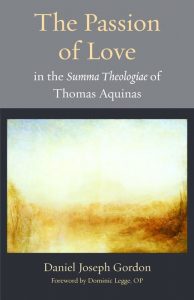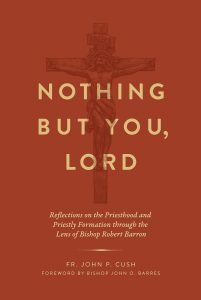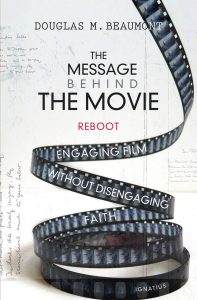The Passion of Love in the Summa Theologiae of Thomas Aquinas. By Daniel Joseph Gordon. Reviewed by David Zettel. (skip to review)
Nothing But You, Lord: Reflections on the Priesthood and Priestly Formation through the Lens of Bishop Robert Barron. By Rev. John P. Cush. Reviewed by Rev. Ryan Connors. (skip to review)
The Message Behind the Movie—Reboot: Engaging Film without Disengaging Faith. By Douglas Beaumont. Reviewed by Rev. Michael Cairnes. (skip to review)
Agrarian Spirit: Cultivating Faith, Community, and the Land. By Norman Wirzba. Reviewed by Christopher Siuzdak. (skip to review)
The Passion of Love in the Summa Theologiae of Thomas Aquinas – Daniel Joseph Gordon
Gordon, Daniel Joseph. The Passion of Love in the Summa Theologiae of Thomas Aquinas. Washington, D.C.: The Catholic University of America Press, 2023. 194 pages.
Reviewed by David Zettel.
 This work aims to provide a theological reading of St. Thomas on the passion of love. Given widespread confusion in the contemporary world over the nature and purpose of love, the topic is a timely one. At the outset, Daniel Joseph Gordon contrasts Thomas’ account with the Romantic view, which sees love as intrinsically valuable: my love is good just because it is love (p. 7).
This work aims to provide a theological reading of St. Thomas on the passion of love. Given widespread confusion in the contemporary world over the nature and purpose of love, the topic is a timely one. At the outset, Daniel Joseph Gordon contrasts Thomas’ account with the Romantic view, which sees love as intrinsically valuable: my love is good just because it is love (p. 7).
Against the Romantic conception of love, Gordon summarizes St. Thomas’ position in two theses (p. 14). The first is found in Dante’s Purgatorio: love is the seed both of every virtue and of every vice. The second is associated with St. Augustine’s famous claim: “My love is my weight.” Love is the gravity or weight pulling us toward either happiness or misery. Our loves can thus complete and perfect us, or they can ruin us; and so everything depends on our loving rightly and well.
The Passion of Love is divided into three parts, each devoted to one of the three questions (qq. 26–28) on the passion of love from the Prima secundae of the Summa theologiae. These questions concern the nature, causes, and effects of love. The book functions both as a commentary on those questions and as an exploration of the ideas found in them; Gordon is at once attentive to the texts and alert to contemporary concerns and applications.
Gordon situates the passion of love within Aquinas’s broader theory of the passions. For the most part, Gordon treats the passions as roughly equivalent to emotions, though he also indicates some ways St. Thomas’ account of the passions differs from our own concept of emotion or feeling (p. 31, n. 32; pgs. 51–55). Gordon emphasizes that love is “the root of all the emotions and passions” (p. 48); it is also not a mere brute feeling, but is able to participate in reason.
This analysis enables us to see that even “negative” emotions ultimately spring from love. For example, hatred is a dissonance with some unwanted object; but we hate something only because it is opposed to what we love. Hatred, Gordon emphasizes, is not necessarily a bad thing; it can be well ordered, and can motivate us to protect what we love and cherish from what threatens it (p. 137). The moral life is not about the triumph of love over hatred, but rather about our loving the right things, and in the right way.
One might worry that a book focused on the passion of love would be too niche for the general reader; but this is not the case. Following St. Thomas’ lead, Gordon uses the emotion or passion of love as a springboard for considering love in all its multifaceted meanings. In an illuminating chapter (ch. 3), he discusses Aquinas’ four “Latin loves” — love (amor), rational love (dilectio), charity (caritas), and friendship (amicitia) — and compares Aquinas’ approach with C.S. Lewis’s classic work, The Four Loves. We thus get a full picture of the range and kinds of love to be found in a complete human life.
Gordon is at pains to emphasize that Aquinas does not have a bloodless, overly cerebral account of love; he makes this especially clear in his discussion of the “effects” of love, which include union, mutual indwelling, ecstasy, and zeal. The picture Gordon paints is an attractive one: love is not a mere duty, but something that delights the lover. He points to passages where St. Thomas’s language verges on the poetic, as when he says that love produces “melting,” which he describes as a softening of the heart that allows the beloved to enter into it (p. 190).
While his examples are frequently drawn from ordinary life, Gordon is especially interested in the spiritual applications of Aquinas’s account. Our loves are ultimately ordered toward the goal of union with God; recognizing that our happiness lies only in Him helps us to make sense of our desires, and to experience the joy of having those desires fulfilled (p. 102).
This book is marvelously readable and accessible to the nonspecialist. Gordon has a teacher’s knack for illustrating theological ideas and philosophical arguments with down-to-earth examples, useful analogies, and literary allusions. Points of technical detail, historical context, and scholarly interest are consigned to the footnotes. This approach can make for some rather unwieldy footnotes, particularly in the first chapter, but it has the virtue of providing clear and easy-to-follow arguments and elucidations. Gordon constantly keeps his readers in mind, advising nonspecialists that they can ignore footnotes (p. 15), and encouraging them to read certain sections quickly, so as not to get lost in the details (p. 22).
I would recommend this book to those wishing to continue and deepen their intellectual formation, those interested in the thought of St. Thomas, and anyone who wants to understand what love is and the role it should play in our lives.
David Zettel is Assistant Professor of Philosophy at Sacred Heart Seminary and School of Theology.
Nothing But You, Lord – John P. Cush
Cush, Rev. John P. Nothing But You, Lord: Reflections on the Priesthood and Priestly Formation through the Lens of Bishop Robert Barron. Elk Grove Village, IL: Word on Fire Catholic Ministries, 2024. 224 pages.
Reviewed by Rev. Ryan Connors.
 Initial and ongoing priestly formation remains an object of special concern for those interested in the renewal of the Church in the contemporary period. In every age, God raises up preachers to instruct the faithful — and especially priests — about the dignity of the Catholic priesthood. Olier, Eudes, Liguori, Manning, Sheen, and John Paul II come immediately to mind as expositors of the truths Catholics hold about what priests uniquely introduce into the world.
Initial and ongoing priestly formation remains an object of special concern for those interested in the renewal of the Church in the contemporary period. In every age, God raises up preachers to instruct the faithful — and especially priests — about the dignity of the Catholic priesthood. Olier, Eudes, Liguori, Manning, Sheen, and John Paul II come immediately to mind as expositors of the truths Catholics hold about what priests uniquely introduce into the world.
In our own time, Bishop Robert Barron has shown himself to be a preacher and shepherd after the heart of Christ. In Nothing But You, Lord, Father John Cush offers a sustained meditation on the priesthood and priestly formation drawing upon the teaching and ministry of the nation’s premier evangelical voice. This Christocentic vision finds expression in Bishop Barron’s episcopal motto which serves as the book’s title.
This eminently readable text unfolds in two parts. The first chapters treat the issues related to priestly identity. Cush prefers to emphasize priestly identity instead of sacramental character to make clear that while the character can never be lost, some priests do succumb to a less than fulsome understanding of their own identity (15). This section consists of an introduction and three chapters on the triple munera of the priesthood (teaching, sanctifying, and governing); the relationship of the priest to his bride the Church according to her four marks (one, holy, Catholic, and apostolic); and the heroic priest as soul-doctor and mystagogue often preached by Bishop Barron.
The second section of the book reads as a companion to the Program of Priestly Formation (2022) for dioceses of the United States based on the Ratio fundamentalis of the Dicastery for the Clergy. This section includes an introduction and chapters on each of the four dimensions of priestly formation, human, spiritual, intellectual, and pastoral. Father Cush credits Pope John Paul II’s 1992 Pastores Dabo Vobis as the “game-changer” (114) in priestly formation in the contemporary period. Cush suggests reading — and re-reading — this text which remains the Church’s most sustained papal reflection on priestly formation.
The chapter on intellectual formation will be welcomed by those who seek to navigate a path that neither deemphasizes the importance of an intellectually well-formed clergy nor one that isolates academics from other dimensions. True enough, a danger can occur in seminary formation in which one who excels in course work could fly under the radar, as it were. Formators are rightly concerned that candidates for the priesthood demonstrate suitability in the four dimensions of priestly formation. The place of St. Thomas Aquinas in Bishop Barron’s theology, as well as the Angelic Doctor’s singular role in the Church’s vision of priestly formation, receive considerable treatment here (171–88).
Readers of this book will welcome the author’s broad consultation of Barron’s entire theological corpus. Cush draws upon both Barron’s scholarly publications as well as his many homilies, lectures, and spiritual conferences. In Bishop Robert Barron, the Church in the United States can boast of the great evangelizer of our age. His unique contribution merits such an in-depth study. Those interested in a genuine renewal of the priesthood will find in this book a helpful guide.
As Bishop John Barres of the Diocese of Rockville Centre aptly notes in the foreword to the book, sound theology and pastoral sensitivity go together. Efforts to separate them or suggest one is possible without the other are doomed to failure — and at great consequence. The author rightly laments the “bookless priest” as one unable to fulfill effectively his pastoral charge (4).
Readers who come across this book might at first glance opine that its purpose is to ensure intellectually well-formed priests and to encourage an ongoing formation especially in theological studies. Fair enough; Bishop Barron justly receives acclaim for demonstrating the effectiveness of informed preaching and robust catechetics. However, readers may be surprised to discover just how spiritually fruitful meditation on these chapters will prove. Father Cush offers the sound counsel of one long engaged in priestly formation. The lens through which he addresses these matters is the teaching of one who has shown himself to be a balanced, prudent, and, at the very same time, courageous apostle of the New Evangelization. Priests and future priests do well to embrace his teaching and follow his example.
Rev. Ryan Connors is a priest of the Diocese of Providence and Rector of the Seminary of Our Lady of Providence (Rhode Island). He is the author of Rethinking Cooperation with Evil: A Virtue-Based Approach (Washington, DC: The Catholic University of America Press, 2024).
The Message Behind the Movie—Reboot – Douglas Beaumont
Beaumont, Douglas. The Message Behind the Movie—Reboot: Engaging Film without Disengaging Faith. San Francisco, CA: Ignatius Press, 2022. 227 pages.
Reviewed by Rev. Michael Cairnes.
 In seminary I took a class called Drama and Ministry in which we were introduced to the elements of drama and how they can serve to deepen our understanding of the history of salvation and pastoral work. It was the first time I had ever been given tools to judge movies based on more than the criterion of how it made me feel. These tools made watching movies an adventure: What does the movie mean? Is it a drama or a tragedy? Who is the protagonist? What do they want? What challenges must they face? Where is the climax?
In seminary I took a class called Drama and Ministry in which we were introduced to the elements of drama and how they can serve to deepen our understanding of the history of salvation and pastoral work. It was the first time I had ever been given tools to judge movies based on more than the criterion of how it made me feel. These tools made watching movies an adventure: What does the movie mean? Is it a drama or a tragedy? Who is the protagonist? What do they want? What challenges must they face? Where is the climax?
The answers to these questions are clear enough in simple movies. Think Romeo and Juliet. They are not so simple when faced with more complex movies. Try watching 2001: A Space Odyssey and figuring out who (or what) the protagonist is. Aristotle argued every story has three parts: a beginning, a middle, and an end. In fact, most screenplays follow this three-act format: introduction, confrontation, and resolution. Fittingly, Douglas M. Beaumont’s book The Message Behind the Movie—Reboot Engaging Film Without Disengaging Faith stays faithful to this classic structure. In three “acts,” Beaumont offers some of the same tools I learned in seminary to understand the meaning of movies, and how their themes are connected with life and faith.
Act one — “How to Watch a Movie” — gives the tools one needs to interpret the meaning of a film. He uses the fairy tale as an example: “Once upon a time in act 1, there lived a protagonist. Things were going great until act 2, when an antagonist came along and presented the protagonist with a challenge. The protagonist later realized that certain actions would have to be taken to meet the challenge. Things kept getting more difficult until the protagonist entered act 3, finally overcame the antagonist’s challenge at the climax, and lived happily ever after” (pg. 36).
We are introduced to the well known “Hero’s Journey,” archetypal characters frequently found in stories, and the functions they serve. Beginning with the premise that everything in a movie is purposeful, we are exhorted to pay attention to everything. Beaumont’s explanation of “style” explores the way a story is told. Stylistic features (profanity/harsh language, violence, and nudity/sexuality) are how the MPAA decides to rate a movie. We are briefly introduced to different genres (romance, western, action/adventure, comedy, science fiction/fantasy, horror, revisionist) and how they can be exploited by fidelity or subversion of the genres tropes. All films express a worldview which we should also pay attention to. It is through an evaluation of a film’s story, style, and worldview that the significance can be discerned.
Act two introduces us to the “conflict.” How can movies serve as opportunities for evangelization and discussions of apologetics in real life? Evangelization is explained as testifying to, clarifying, and justifying the faith. This is followed by a kind of introduction to apologetics against skepticism, for God’s existence, and for the historical truth of Christianity.
The final and third act is a brief moral evaluation of which movies are appropriate, for whom, and why. We are given a “resolution” that draws everything together with a clever analysis of The Truman Show.
I would have been more satisfied with the book if it gave a deeper discussion of the nature of art and Christianity. When mentioned, these topics are more walked around than they are faced directly. For example, the word entertainment is used throughout the book. However, it is never criticized as a criterion for judging a movie, its meaning for how we experience the world, or if it is meant to distract us from the drama of our lives. Christianity is defended and evangelization is promoted, but there is never a discussion about what the very nature of Christianity is itself. This can cause further confusion for many Christians, for whom faith is often unknowingly reduced to ideology or morality. One could imagine any ideologue using the principles of evangelization found in this book to promote their ideology by speaking about movies.
Beaumont’s book is ambitious. It is essentially a primer in Christian apologetics and evangelization using film analysis as its starting point. As such, its target audience is high school and college age neophytes in film and faith. If you are interested in watching movies intentionally and getting more out of them, then the first part of the book is good by itself. Anybody interested in Christian apologetics itself would be better served by getting a book solely dedicated to the subject.
Rev. Michael Cairnes, STL, is a priest of the Diocese of Palm Beach. He received his STL in the New Evangelization from the Pontifical University of Saint Thomas Aquinas through the faculty of Sacred Heart Major Seminary in Detroit. He currently serves as parochial vicar at the Cathedral of Saint Ignatius Loyola.
Agrarian Spirit – Norman Wirzba
Wirzba, Norman. Agrarian Spirit: Cultivating Faith, Community, and the Land (Notre Dame, IN: University of Notre Dame Press, 2022). 247 pages.
Reviewed by Christopher Siuzdak.
 Firmly situated within a Christian framework, this insightful work expounds a widely applicable spirituality informed by agrarian sensibilities. It is not a compendium of pious platitudes for farmers. The target audience, rather, is everybody in the consumerist economy who is prone to “shop and purchase their way through life” (ix) and those who buy into (or are tempted to subscribe to) the regnant paradigm of atomized individualism. The “definitive marker” of the agrarian spirit, the author explains, “is being committed to the flourishing of people, fellow creatures, and the land altogether” (emphasis original, xi). In this sense, Jesus Christ himself was an agrarian because “he focused his love on, and put his body to work for, the well-being of all creatures and the good of all creation” (52). Jesus, in his ministry, “demonstrated that the goal is not to flee this world but to nurture, heal, reconcile, and befriend it” (50). Christians, as emulators of Christ, are called to be catalysts for reconciliation where disconnection exists within creation and between creation and the Creator, whose signature traits are creating, sustaining, nurturing, liberating, empowering, and healing (ix).
Firmly situated within a Christian framework, this insightful work expounds a widely applicable spirituality informed by agrarian sensibilities. It is not a compendium of pious platitudes for farmers. The target audience, rather, is everybody in the consumerist economy who is prone to “shop and purchase their way through life” (ix) and those who buy into (or are tempted to subscribe to) the regnant paradigm of atomized individualism. The “definitive marker” of the agrarian spirit, the author explains, “is being committed to the flourishing of people, fellow creatures, and the land altogether” (emphasis original, xi). In this sense, Jesus Christ himself was an agrarian because “he focused his love on, and put his body to work for, the well-being of all creatures and the good of all creation” (52). Jesus, in his ministry, “demonstrated that the goal is not to flee this world but to nurture, heal, reconcile, and befriend it” (50). Christians, as emulators of Christ, are called to be catalysts for reconciliation where disconnection exists within creation and between creation and the Creator, whose signature traits are creating, sustaining, nurturing, liberating, empowering, and healing (ix).
The first chapter, entitled “On Not Losing Creation,” begins at the beginning: the creation of the cosmos. God created not out of necessity, but out of a superabundance of love. “Created beings and places are not simply the focus or object of God’s love and attention. They are also, and in ways we do not fully understand, the material means and the embodied expressions of divine love (italics originals, 5). In other words, the world is “God’s own love variously made visible, tactile, auditory, fragrant, and nutritious” (4). The author concludes that “material reality is never to be despised or rejected because in doing so one would also be despising the divine love that is constantly animating and circulating through it” (5). This line is reminiscent of the Jesuit poet Gerard Manley Hopkins, who wrote that “the world is charged with the grandeur of God.” The agrarian spirituality the author expounds unmistakably espouses an analogical or sacramental imagination, which accentuates creation in God’s image and likeness (instead of emphasizing the otherness of the Creator and creation), highlights the incarnation and resurrection as an affirmation of creation (rather than highlighting human sinfulness), and a foretaste of the Kingdom of God in justice, peace, and love (rather than the not-yet dimension of the reign of God). Coming from God, “the value of creatures, along with their purposes and ends, is grounded in their God-given sanctity rather than in what we decide to make of them” (127).
The second chapter, entitled “Why Agrarian?,” argues that “people are landed beings and so cannot possibly thrive apart from the thriving of the land and its many creatures” (15). A vibrant future depends on seeing natural resources and fellow creatures “as gracious gifts and not merely units of production or consumption” (13). Manual work increases the depth of perception. In this chapter, the author admits that nostalgia is insufficient and indeed wayward because “the history of agricultural communities is saturated with abuse, slavery, racism, xenophobia, sexism, and neglect” (14).
In the third chapter, entitled “Placing the Soul,” the author addresses otherworldly impulses ranging from the ancient philosopher Plato to the present-day “scientists and wealthy elites who are planning their escape to another planet” (31). The author’s spirituality seeks to overcome dualistic conceptions and be world-affirming. The author, however, fails to sufficiently make sense of world-denying impulses within the Christian tradition among figures who were and continue to be recognized as unmistakably holy. There have been numerous saints throughout the two millennia of Christianity’s history who have been otherworldly or extremely world-despising. The stylites, for instance, fasted in their bird-like perches atop sun-scorched pillars and medieval monks prayed in coffin-like cells too tiny to permit standing up or lying down. It is unsatisfactory to label these ascetics as “escapists,” “dualists,” or “Platonists.” The author’s contention that “the idea that people should want to flee their bodies so as to ascend to somewhere else to be with God simply does not make sense, because the place where God is, is the place where creatures are” (53) does not sit comfortably. The work would have benefitted from a more sustained discussion of how the asceticism that has been practiced within the Christian tradition fits together with more world-affirming strands of the Christian tradition.
The problems plaguing a proper understanding of materiality and embodiment are not limited to antiquity. Modern thinkers promoted “the deprecation of the material world” “though the elimination of a natural telos in things, the idea that natural things have an end or purpose internal to themselves” (35). “In this modern sensibility, the classically conceived paradigmatic person as one who contemplates the natural order of things (so as to better fit within it) is replaced with the image of the engineer who redesigns nature (so as to have it serve human interests)” (35).
Modernity has atrophied the appreciation for relations and ties. The author reminds readers: “A person’s life is not his or her own possession” (52). He further explains: “A life is not a single, separable, self-standing thing. It is, instead, a knotting of lines of codevelopment that together make a tapestry or meshwork. A living body cannot be a single, self-sourcing kind of reality because each body depends on the nurture and support of countless seen and unseen others” (40).
The book proceeds to part two, which showcases agrarian spiritual exercises. In the fourth chapter, the author advocates for a habit of prayer, explaining that “praying seeks to orient people so that they can live in their world in a more compassionate manner” (62). Prayer requires the discipline of attention, as do love and justice. “The cultivation of this habit of attention enabled Rodin to find joy and beauty in the smallest of things he sensed the miracle of their being in ways that few people do” (66). The author writes, “If it is the case that we are transformed by what we give our attention to, then the giving and withholding of attention are matters of the highest practical and personal concern” (70). In sum, “To pray is to ask that the love of God should grow and become ever more deeply rooted in one’s life” (72). Prayer transforms the person from grasping and controlling into receiving and sharing (78).
The fifth chapter is about learning to see as God sees. The sixth chapter underscores that one “grows out of a place” rather than merely lives on it” (111). The author argues: “From a scriptural point of view, the thought that the destination of our spiritual ambition ought to be somewhere beyond earth is misguided because God’s orientation, especially as revealed in the becoming flesh and becoming practical in the life of Jesus, is down, around, and with creatures in their places.” Importantly, Merton explained detachment thus: we do not detach ourselves from things in order to attach ourselves to God, but rather we become detached from ourselves in order to see and use all things in and for God” (116).
The seventh chapter aims “to develop an account of humility that is attuned to creaturely need and vulnerability but is also directed to cultivating the sympathy and gentleness that are crucial for the healing of our wounded communities and places” (134). The eight chapter treats generosity. “Generosity is the fire that is sparked by gratitude” (155). As a practical matter, the author highlights the Shaker practice of starting each meal with two minutes of silence “so as to come more gently and courteously in the presence of what they are about to eat” (166). The author points out that though the economies “created standards of living unimaginable to people of previous generations, many feel the stress of not having enough or are anxious that what they have will be taken away or rendered obsolescent” (167). The author recommends such practices as: eating together, practicing a day of rest, establishing a routine in which you regularly give something to others, practicing celebration, growing some food, practicing neighborliness, punctuating each day with a time of thanksgiving, developing useful skills that can be a benefit to others, and supporting local economies and financial institutions since these create opportunities for consumers and producers to learn from each other about shared needs, potential, and responsibility (173–175). As the author highlights, “Shortening the distance between production and consumption makes it more likely that people will understand the history of things coming to be” (175). In the final chapter, the author addresses hope: “A hopeful life is founded upon resonant relationships in which confession and care, and repentance and a commitment to healing are primary practices” (194). In sum, the author convincingly contends that Christianity involves a transformation of this world, rather than transportation to another (71).
All in all, this is an insightful book that can be a launchpad for discussion and action. Wirzba provides a sound spirituality to undergird the ecological movement. This work could have addressed in a more head-on manner the question of whether humankind is the pinnacle of creation and how a hierarchy of being (ontology) can coexist with an ecologically-informed spirituality that accords due respect for non-human beings. Future works could factor agrarian sensibilities into the frameworks of other major world religions.
Christopher Siuzdak is Book Review Editor for the Homiletic & Pastoral Review.

Recent Comments